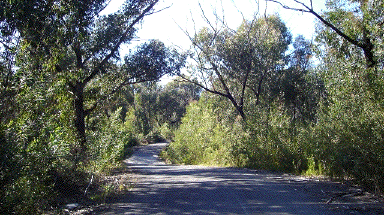
Cawley today, situated between Helensburgh and Waterfall on Cawley Road, is just a name on a map, an area of land along a small creek of the same name, but in the late 1800s through to the early 1900s, it was a bustling settlement housing many hundreds of railway workers and their families.
The actual site of the village is now part of the Garrawarra State Conservation Area. Cawley is reached by driving to the Helensburgh railway station, over the railway bridge, along Wilsons Creek Road, over the second railway bridge and turning right into the Garrawarra State Conservation Area. The dirt road soon becomes a tarred road which soon fords three small creeks, all of which are Cawley Creek. The area around the first creek crossed is where the village was laid out. Immediately to the right, before crossing the first creek, is a cutting which makes its way to the northern end of the now unused Cawley railway tunnel.
Little remains to indicate that the bushland has ever been disturbed. In railway terms, the township was at the 126 mile peg from the Sydney terminus. The village was laid out in quarters for single workers and families, shop and a school for 50 pupils, railway station, a post office, two residences and a hotel (better described as “a sly grog shop”).
The area and the creek, take their names from an old farming family who, along with two other old identities, farmed the whole area between Waterfall and Helensburgh, long before the Royal National Park was established. Each of the creeks in the area took on the names of the farmers: Wilsons Creek just below Helensburgh Railway Station, Cawley Creek and Frews Creek forming the northern boundary of the Wollongong City Council LGA.
Cawley railway station was largely used for the receipt of goods for the construction of the railway, as well as supplies for the Metropolitan Colliery which was being developed at this time.
During most of the time that the station was in operation, Mr Robert Frew was the station master and Mr Percy Reach was the night officer. They worked the station between them, each doing a 12 hour shift. The station master’s wage at the time averaged about £200 per year.
Two local identities who were born at Cawley were Mr Samuel Frew and Mrs Sarah Stork. Samuel Frew was to become the proprietor of “The Helensburgh News”, later called “The Helensburgh and Scarborough News”, the second newspaper to operate in Helensburgh. Samuel was the son of Robert Frew. He also served for some years as an alderman on the Wollongong City Council. Sarah Stork was to make her home in Waterfall and was to become the proprietor of the Waterfall Bus Service. For many years it was a horse drawn affair, transporting people from Waterfall Station to the Waterfall Sanatorium, Garie Beach and Woronora Dam. For further information on Sarah Stork, click here.
Cawley Creek School opened in February 1886 and was officially, and rather confusingly, named Heathcote Public School. The name was corrected in August 1886 due to the opening of the real Heathcote Public School in November 1886. Until the Helensburgh School opened on July 11, 1887, between 30 and 40 pupils from Helensburgh walked the two miles along Cawley Road to attend Cawley School. Cawley School was closed in October 1887 and the corrugated iron school building was moved to Helensburgh where a new school was under construction. The Cawley School became the kitchen and bathroom of the headmaster’s residence which was under construction at the time.
The Cawley Post Office opened on January 1, 1886 and continued until January 14, 1888. By that time the major construction work on the railway track had been completed and the workers had moved further down the line to Otford and Coalcliff.
Slowly, railway equipment was removed and the site allowed to return to rural pursuits. The village disappeared as the remaining buildings were shifted to Helensburgh with the formation of the Royal National Park.